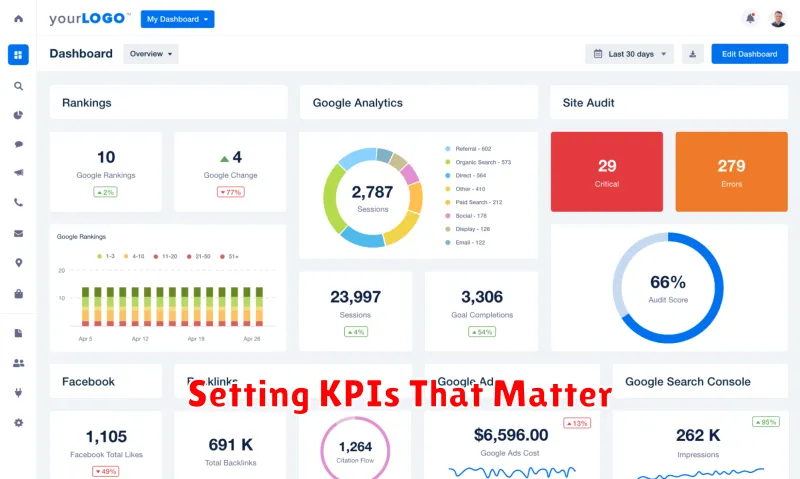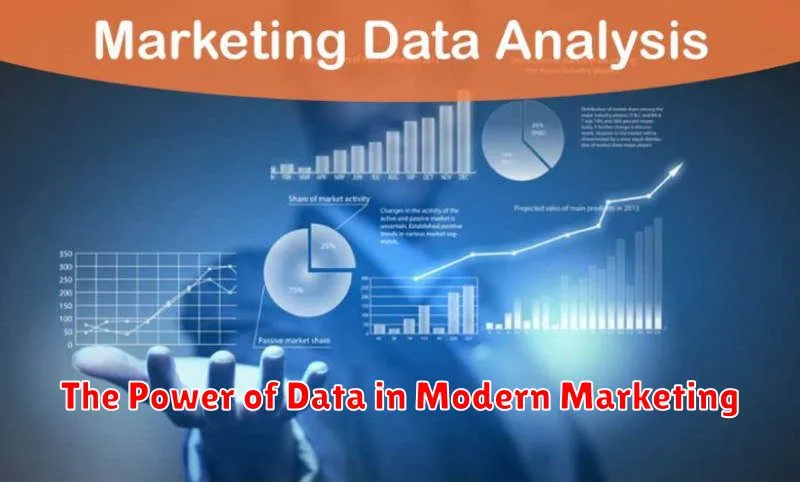In today’s rapidly evolving digital landscape, data has become the lifeblood of modern marketing. Harnessing the power of data provides businesses with unparalleled insights into consumer behavior, market trends, and campaign performance. This allows for data-driven decision-making, a crucial element for staying competitive and achieving sustainable growth. From understanding customer preferences and personalizing experiences to optimizing campaigns and measuring ROI, the impact of data is undeniable. This article will delve into the various ways businesses can leverage the power of data to enhance their marketing strategies and achieve tangible results.
Data analysis and data-driven marketing are no longer optional, but rather essential components of a successful modern marketing approach. By understanding how to collect, analyze, and interpret data, businesses can unlock a wealth of opportunities to connect with their target audience on a deeper level. This article will explore key concepts such as data collection, data analytics, data visualization, and the ethical considerations surrounding the use of data in marketing. Prepare to discover how the power of data can transform your marketing efforts and propel your business forward.
Why Data Is Central to Strategy
In today’s dynamic market, data has become the bedrock of effective marketing strategies. It provides actionable insights that drive informed decisions, moving businesses away from guesswork and toward calculated approaches. Data empowers marketers to understand their target audience on a granular level, allowing for personalized messaging and targeted campaigns.
Data-driven strategies enable businesses to optimize resource allocation, maximizing ROI and minimizing wasteful spending. By analyzing market trends, customer behavior, and campaign performance, marketers can identify what works, what doesn’t, and where adjustments are needed. This iterative process of refinement leads to continuous improvement and increased marketing effectiveness.
Furthermore, data facilitates predictive modeling. By identifying patterns and trends, businesses can anticipate future market shifts and customer needs. This foresight allows them to proactively adapt their strategies, gaining a competitive edge and staying ahead of the curve.
Without data, marketing strategies often rely on intuition and assumptions. This approach can lead to misaligned campaigns, wasted resources, and missed opportunities. In the modern marketing landscape, data is not just an asset; it is a necessity for survival and success.
Types of Marketing Data to Track
In today’s data-driven world, marketers have access to a wealth of information that can inform and optimize campaigns. Tracking the right data is crucial for understanding customer behavior, measuring campaign effectiveness, and ultimately driving business growth. Several key data types should be on every marketer’s radar.
Website Analytics provide insights into user behavior on your website. Metrics like bounce rate, time on page, and conversion rates offer valuable information about the effectiveness of your website content and user experience. Tracking these metrics helps identify areas for improvement and optimize website performance.
Social Media Analytics focuses on engagement, reach, and follower growth. Monitoring these metrics allows you to understand how your audience interacts with your brand on social platforms and tailor content accordingly. Sentiment analysis can also reveal public perception of your brand.
Advertising Performance Data offers crucial insights into campaign effectiveness. Metrics like click-through rates (CTR), cost-per-click (CPC), and conversion rates help determine which campaigns are performing well and which need adjustments. This data allows for efficient budget allocation and maximized return on investment (ROI).
Sales Data links marketing efforts to revenue generation. By tracking leads, conversions, and customer lifetime value, you can directly measure the impact of marketing activities on the bottom line. This allows for data-backed decisions regarding resource allocation and strategic planning.
Setting KPIs That Matter

In the data-driven landscape of modern marketing, setting the right Key Performance Indicators (KPIs) is crucial for measuring success and driving effective strategies. KPIs should directly align with your overall business objectives and marketing goals. Choosing vanity metrics that look impressive but don’t impact the bottom line is a common pitfall to avoid.
Focus on KPIs that provide actionable insights. For example, instead of solely tracking website traffic, prioritize metrics like conversion rates, customer lifetime value (CLTV), and return on ad spend (ROAS). These KPIs offer a clearer picture of marketing campaign effectiveness and profitability.
Consider using a balanced scorecard approach to cover key areas like customer acquisition, customer retention, and revenue generation. This ensures a holistic view of marketing performance. Regularly review and refine your KPIs as business goals evolve and market conditions change.
Examples of effective marketing KPIs:
- Website Conversion Rate
- Customer Acquisition Cost (CAC)
- Customer Lifetime Value (CLTV)
- Return on Ad Spend (ROAS)
- Net Promoter Score (NPS)
Using Google Analytics Effectively
Google Analytics is a powerful, free tool providing invaluable insights into website traffic and user behavior. Effective use of this platform is crucial for data-driven marketing strategies.
Setting up goals and conversions allows for accurate measurement of campaign performance. Whether it’s tracking form submissions, downloads, or purchases, defining these key actions provides clear metrics for success.
Analyzing user demographics, interests, and behavior helps refine targeting and personalize content. Understanding where your audience comes from, what devices they use, and how they interact with your website enables more effective engagement.
Regularly reviewing key metrics such as bounce rate, time on site, and pages per visit offers valuable insights into content effectiveness and user experience. Identifying areas for improvement and optimizing content based on this data is essential for maximizing impact.
Utilizing custom reports allows for focused analysis of specific data points, tailoring reports to answer specific business questions and uncover deeper insights beyond the standard dashboards.
Attribution Modeling Basics
Attribution modeling is the process of determining which marketing touchpoints deserve credit for a conversion. It helps marketers understand the customer journey and optimize campaigns for better ROI. Instead of giving all the credit to the last click, attribution models distribute credit across various touchpoints like display ads, social media, email, and organic search.
Several attribution models exist, each with its own approach. The last-click model, while simple, often misrepresents the true impact of earlier touchpoints. Other models include first-click, which attributes all credit to the first interaction, linear, which distributes credit evenly, and time decay, which gives more weight to interactions closer to the conversion.
Data-driven attribution leverages algorithms to analyze historical data and assign credit based on actual contribution. This model provides a more nuanced and accurate picture of marketing performance, allowing for more effective budget allocation and strategy adjustments. Choosing the right attribution model depends on the specific business, its industry, and marketing goals.
Customer Journey Insights
Data empowers marketers to gain deep insights into the customer journey. By analyzing data from various touchpoints, businesses can understand how customers interact with their brand, from initial awareness to post-purchase engagement.
Touchpoint analysis reveals crucial interaction patterns. This data helps pinpoint areas of friction, enabling marketers to optimize the customer experience. For example, high abandonment rates on a specific checkout page could indicate a usability issue. Addressing this issue directly improves conversion rates and customer satisfaction.
Furthermore, journey mapping helps visualize the customer experience. By understanding the typical steps a customer takes, marketers can personalize interactions at each stage. This targeted approach can lead to increased engagement and stronger customer relationships.
Data-driven insights are essential for identifying key customer segments and their respective behaviors. This information is crucial for tailoring marketing messages and offers, ultimately improving campaign effectiveness and ROI.
Predictive Analytics in Marketing
Predictive analytics plays a crucial role in modern marketing, enabling businesses to anticipate future customer behavior. By leveraging historical data and statistical algorithms, marketers can gain valuable insights into customer preferences, purchase patterns, and responses to marketing campaigns. This allows for more effective targeting and personalization.
Key applications of predictive analytics include:
- Customer churn prediction: Identifying customers at risk of leaving allows for proactive retention strategies.
- Lead scoring: Prioritizing leads based on their likelihood to convert improves sales efficiency.
- Campaign optimization: Predicting campaign performance helps allocate resources effectively and maximize ROI.
- Personalized recommendations: Tailoring product suggestions based on individual customer profiles enhances customer experience and drives sales.
Implementing predictive analytics requires high-quality data and the right tools. However, the potential benefits, including improved customer relationships, increased revenue, and a competitive advantage, make it a worthwhile investment for businesses seeking to thrive in the data-driven marketplace.
Tools for Data Visualization
Data visualization transforms raw data into easily understandable visuals, enabling marketers to grasp complex trends and patterns. Selecting the right tool is crucial for effective data storytelling.
Tableau and Power BI are robust platforms for creating interactive dashboards and reports. They offer extensive features for connecting to various data sources, performing advanced analytics, and sharing visualizations.
Google Data Studio provides a user-friendly interface for building customizable reports and dashboards, particularly beneficial for visualizing data from Google’s marketing platforms. Its free availability makes it an accessible option for many.
For more code-centric approaches, libraries like Python’s Matplotlib and Seaborn, along with R’s ggplot2, provide granular control over visualization creation and customization, making them ideal for complex visualizations and statistical modeling.
How to Avoid Data Overload
In today’s data-driven marketing landscape, the sheer volume of available information can be overwhelming. Prioritizing relevant data is crucial for effective decision-making. Start by clearly defining your marketing objectives. What are you trying to achieve? This focus will guide your data selection process.
Invest in robust data management tools. These tools can automate data collection, cleaning, and analysis, freeing up your team to focus on strategic insights. Look for platforms that offer data visualization features, making it easier to identify trends and patterns.
Filtering is essential for managing data overload. Establish clear criteria for the data you collect and analyze. Avoid the temptation to gather everything “just in case.” Focus on data directly related to your key performance indicators (KPIs).
Regularly review and refine your data sources. Data sources can become obsolete or less relevant over time. Periodically assess the value of each source and eliminate those that no longer contribute meaningful insights. This streamlines your data flow and improves efficiency.
Finally, collaboration is key. Foster open communication between your marketing and data analytics teams. Ensure everyone understands the goals and the relevance of the data being collected and analyzed. This collaborative approach can prevent data silos and maximize the value of your data insights.
Making Decisions with Confidence
In today’s complex marketing landscape, data-driven decision making is no longer a luxury, but a necessity. Leveraging data empowers marketers to move beyond gut feelings and make informed choices that yield measurable results.
Data analytics provides critical insights into consumer behavior, market trends, and campaign performance. By analyzing website traffic, social media engagement, and sales data, marketers can identify what resonates with their target audience and what doesn’t. This understanding allows for strategic adjustments to campaigns, ensuring optimal resource allocation and maximizing ROI.
Furthermore, data allows for precise targeting. By segmenting audiences based on demographics, interests, and behaviors, marketers can tailor their messages for maximum impact. This personalized approach not only improves campaign effectiveness but also fosters stronger customer relationships.
With data as their guide, marketers can confidently navigate the ever-evolving marketing landscape, optimize their strategies, and achieve tangible business outcomes. The ability to measure and track campaign performance provides concrete evidence of success, justifying marketing spend and demonstrating the value of data-driven strategies.

